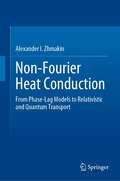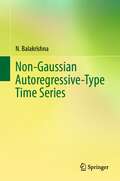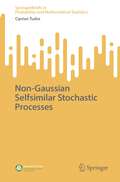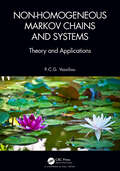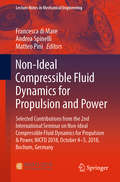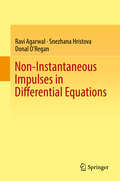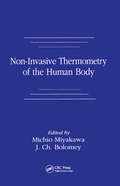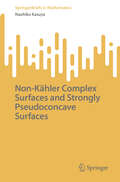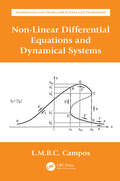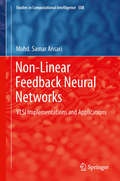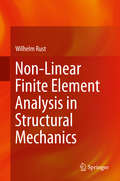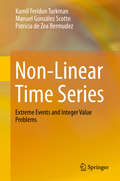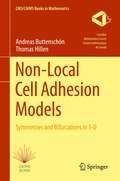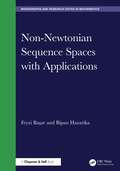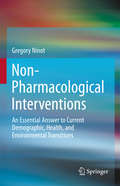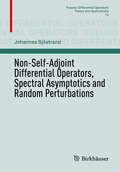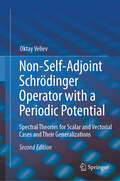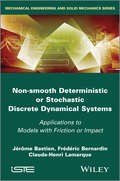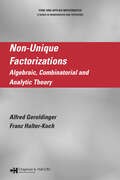- Table View
- List View
Non-Fourier Heat Conduction: From Phase-Lag Models to Relativistic and Quantum Transport
by Alexander I. ZhmakinThis book presents a broad and well-structured overview of various non-Fourier heat conduction models. The classical Fourier heat conduction model is valid for most macroscopic problems. However, it fails when the wave nature of the heat propagation becomes dominant and memory or non-local spatial effects become significant; e.g., during ultrafast heating, heat transfer at the nanoscale, in granular and porous materials, at extremely high values of the heat flux, or in heat transfer in biological tissues. The book looks at numerous non-Fourier heat conduction models that incorporate time non-locality for materials with memory, such as hereditary materials, including fractional hereditary materials, and/or spatial non-locality, i.e. materials with a non-homogeneous inner structure. Beginning with an introduction to classical transport theory, including phase-lag, phonon, and thermomass models, the book then looks at various aspects of relativistic and quantum transport, including approaches based on the Landauer formalism as well as the Green-Kubo theory of linear response. Featuring an appendix that provides an introduction to methods in fractional calculus, this book is a valuable resource for any researcher interested in theoretical and numerical aspects of complex, non-trivial heat conduction problems.
Non-Gaussian Autoregressive-Type Time Series
by N. BalakrishnaThis book brings together a variety of non-Gaussian autoregressive-type models to analyze time-series data. This book collects and collates most of the available models in the field and provide their probabilistic and inferential properties. This book classifies the stationary time-series models into different groups such as linear stationary models with non-Gaussian innovations, linear stationary models with non-Gaussian marginal distributions, product autoregressive models and minification models. Even though several non-Gaussian time-series models are available in the literature, most of them are focusing on the model structure and the probabilistic properties.
Non-Gaussian Selfsimilar Stochastic Processes (SpringerBriefs in Probability and Mathematical Statistics)
by Ciprian TudorThis book offers an introduction to the field of stochastic analysis of Hermite processes. These selfsimilar stochastic processes with stationary increments live in a Wiener chaos and include the fractional Brownian motion, the only Gaussian process in this class. Using the Wiener chaos theory and multiple stochastic integrals, the book covers the main properties of Hermite processes and their multiparameter counterparts, the Hermite sheets. It delves into the probability distribution of these stochastic processes and their sample paths, while also presenting the basics of stochastic integration theory with respect to Hermite processes and sheets. The book goes beyond theory and provides a thorough analysis of physical models driven by Hermite noise, including the Hermite Ornstein-Uhlenbeck process and the solution to the stochastic heat equation driven by such a random perturbation. Moreover, it explores up-to-date topics central to current research in statistical inference for Hermite-driven models.
Non-Hausdorff Topology and Domain Theory
by Jean Goubault-LarrecqThis unique book on modern topology looks well beyond traditional treatises and explores spaces that may, but need not, be Hausdorff. This is essential for domain theory, the cornerstone of semantics of computer languages, where the Scott topology is almost never Hausdorff. For the first time in a single volume, this book covers basic material on metric and topological spaces, advanced material on complete partial orders, Stone duality, stable compactness, quasi-metric spaces and much more. An early chapter on metric spaces serves as an invitation to the topic (continuity, limits, compactness, completeness) and forms a complete introductory course by itself. Graduate students and researchers alike will enjoy exploring this treasure trove of results. Full proofs are given, as well as motivating ideas, clear explanations, illuminating examples, application exercises and some more challenging problems for more advanced readers.
Non-Hermitian Hamiltonians in Quantum Physics
by Fabio Bagarello Roberto Passante Camillo TrapaniThis book presents the Proceedings of the 15th International Conference on Non-Hermitian Hamiltonians in Quantum Physics, held in Palermo, Italy, from 18 to 23 May 2015. Non-Hermitian operators, and non-Hermitian Hamiltonians in particular, have recently received considerable attention from both the mathematics and physics communities. There has been a growing interest in non-Hermitian Hamiltonians in quantum physics since the discovery that PT-symmetric Hamiltonians can have a real spectrum and thus a physical relevance. The main subjects considered in this book include: PT-symmetry in quantum physics, PT-optics, Spectral singularities and spectral techniques, Indefinite-metric theories, Open quantum systems, Krein space methods, and Biorthogonal systems and applications. The book also provides a summary of recent advances in pseudo-Hermitian Hamiltonians and PT-symmetric Hamiltonians, as well as their applications in quantum physics and in the theory of open quantum systems.
Non-Homogeneous Markov Chains and Systems: Theory and Applications
by P.-C.G. VassiliouNon-Homogeneous Markov Chains and Systems: Theory and Applications fulfills two principal goals. It is devoted to the study of non-homogeneous Markov chains in the first part, and to the evolution of the theory and applications of non-homogeneous Markov systems (populations) in the second. The book is self-contained, requiring a moderate background in basic probability theory and linear algebra, common to most undergraduate programs in mathematics, statistics, and applied probability. There are some advanced parts, which need measure theory and other advanced mathematics, but the readers are alerted to these so they may focus on the basic results. Features A broad and accessible overview of non-homogeneous Markov chains and systems Fills a significant gap in the current literature A good balance of theory and applications, with advanced mathematical details separated from the main results Many illustrative examples of potential applications from a variety of fields Suitable for use as a course text for postgraduate students of applied probability, or for self-study Potential applications included could lead to other quantitative areas The book is primarily aimed at postgraduate students, researchers, and practitioners in applied probability and statistics, and the presentation has been planned and structured in a way to provide flexibility in topic selection so that the text can be adapted to meet the demands of different course outlines. The text could be used to teach a course to students studying applied probability at a postgraduate level or for self-study. It includes many illustrative examples of potential applications, in order to be useful to researchers from a variety of fields.
Non-Homogeneous Random Walks: Lyapunov Function Methods for Near-Critical Stochastic Systems
by Mikhail Menshikov Serguei Popov Andrew WadeStochastic systems provide powerful abstract models for a variety of important real-life applications: for example, power supply, traffic flow, data transmission. They (and the real systems they model) are often subject to phase transitions, behaving in one way when a parameter is below a certain critical value, then switching behaviour as soon as that critical value is reached. In a real system, we do not necessarily have control over all the parameter values, so it is important to know how to find critical points and to understand system behaviour near these points. This book is a modern presentation of the 'semimartingale' or 'Lyapunov function' method applied to near-critical stochastic systems, exemplified by non-homogeneous random walks. Applications treat near-critical stochastic systems and range across modern probability theory from stochastic billiards models to interacting particle systems. Spatially non-homogeneous random walks are explored in depth, as they provide prototypical near-critical systems.
Non-Ideal Compressible Fluid Dynamics for Propulsion and Power: Selected Contributions from the 2nd International Seminar on Non-Ideal Compressible Fluid Dynamics for Propulsion & Power, NICFD 2018, October 4-5, 2018, Bochum, Germany (Lecture Notes in Mechanical Engineering)
by Francesca Di Mare Andrea Spinelli Matteo PiniThis book reports on advanced theories and methods aimed at characterizing the dynamics of non-ideal compressible fluids. A special emphasis is given to research fostering the use of non-ideal compressible fluids for propulsion and power engineering. Both numerical and experimental studies, as well as simulations, are described in the book, which is based on selected contributions and keynote lectures presented at the 2nd International Seminar on Non-Ideal Compressible-Fluid Dynamics for Propulsion & Power. Held on October 4-5 in Bochum, Germany, the seminar aimed at fostering collaborations between academics and professionals. The two perspectives have been gathered together in this book, which offers a timely guide to advanced fundamentals, innovative methods and current applications of non-ideal compressible fluids to developing turbomachines, and for propulsion and power generation.
Non-Instantaneous Impulses in Differential Equations
by Ravi Agarwal Snezhana Hristova Donal O’reganThis monograph is the first published book devoted to the theory of differential equations with non-instantaneous impulses. It aims to equip the reader with mathematical models and theory behind real life processes in physics, biology, population dynamics, ecology and pharmacokinetics. The authors examine a wide scope of differential equations with non-instantaneous impulses through three comprehensive chapters, providing an all-rounded and unique presentation on the topic, including: - Ordinary differential equations with non-instantaneous impulses (scalar and n-dimensional case) - Fractional differential equa tions with non-instantaneous impulses (with Caputo fractional derivatives of order q ϵ (0, 1)) - Ordinary differential equations with non-instantaneous impulses occurring at random moments (with exponential, Erlang, or Gamma distribution) Each chapter focuses on theory, proofs and examples, and contains numerous graphs to enrich the reader's understanding. Additionally, a carefully selected bibliography is included. Graduate students at various levels as well as researchers in differential equations and related fields will find this a valuable resource of both introductory and advanced material.
Non-Invasive Thermometry of the Human Body
by Michio Miyakawa J. Ch. BolomeyThis exciting book describes the latest technology in non-invasive thermometry that measures temperature distribution, with discussions focusing on image-based techniques. This is the first book devoted entirely to this topic. An international team of experts detail all important techniques for possible non-invasive thermometry. Descriptions of each technique explain in depth the principles of measurement, the measurement system, obtained temperature image, and the future prospects for the method.
Non-Kähler Complex Surfaces and Strongly Pseudoconcave Surfaces (SpringerBriefs in Mathematics)
by Naohiko KasuyaThe main themes of this book are non-Kähler complex surfaces and strongly pseudoconcave complex surfaces. Though there are several notable examples of compact non-Kähler surfaces, including Hopf surfaces, Kodaira surfaces, and Inoue surfaces, these subjects have been regarded as secondary to Kähler manifolds and strongly pseudoconvex manifolds. Recently, however, the existence of uncountably many non-Kähler complex structures on the 4-dimensional Euclidean space has been shown by Di Scala, Kasuya, and Zuddas through their construction. Furthermore, Kasuya and Zuddas' handlebody construction reveals that strongly pseudoconcave surfaces have flexibility with respect to both four-dimensional topology and boundary contact structures. These constructions are based on the knowledge of differential topology and contact geometry, and provide examples of fruitful applications of these areas to complex geometry. Thus, for (especially non-compact) non-Kähler complex surfaces and strongly pseudoconcave complex surfaces, it is not an exaggeration to say that the research is still in its infancy, with numerous areas yet to be explored and expected to develop in the future.
Non-Linear Differential Equations and Dynamical Systems (Mathematics and Physics for Science and Technology)
by Luis Manuel Braga da Costa CamposNon-Linear Differential Equations and Dynamical Systems is the second book within Ordinary Differential Equations with Applications to Trajectories and Vibrations, Six-volume Set. As a set, they are the fourth volume in the series Mathematics and Physics Applied to Science and Technology. This second book consists of two chapters (chapters 3 and 4 of the set). The first chapter considers non-linear differential equations of first order, including variable coefficients. A first-order differential equation is equivalent to a first-order differential in two variables. The differentials of order higher than the first and with more than two variables are also considered. The applications include the representation of vector fields by potentials. The second chapter in the book starts with linear oscillators with coefficients varying with time, including parametric resonance. It proceeds to non-linear oscillators including non-linear resonance, amplitude jumps, and hysteresis. The non-linear restoring and friction forces also apply to electromechanical dynamos. These are examples of dynamical systems with bifurcations that may lead to chaotic motions. Presents general first-order differential equations including non-linear like the Ricatti equation Discusses differentials of the first or higher order in two or more variables Includes discretization of differential equations as finite difference equations Describes parametric resonance of linear time dependent oscillators specified by the Mathieu functions and other methods Examines non-linear oscillations and damping of dynamical systems including bifurcations and chaotic motions
Non-Linear Feedback Neural Networks: VLSI Implementations and Applications
by Mohd. Samar AnsariThis book aims to present a viable alternative to the Hopfield Neural Network (HNN) model for analog computation. It is well known the standard HNN suffers from problems of convergence to local minima, and requirement of a large number of neurons and synaptic weights. Therefore, improved solutions are needed. The non-linear synapse neural network (NoSyNN) is one such possibility and is discussed in detail in this book. This book also discusses the applications in computationally intensive tasks like graph coloring, ranking, and linear as well as quadratic programming. The material in the book is useful to students, researchers and academician working in the area of analog computation.
Non-Linear Finite Element Analysis in Structural Mechanics
by Wilhelm RustThis monograph describes the numerical analysis of non-linearities in structural mechanics, i. e. large rotations, large strain (geometric non-linearities), non-linear material behaviour, in particular elasto-plasticity as well as time-dependent behaviour, and contact. Based on that, the book treats stability problems and limit-load analyses, as well as non-linear equations of a large number of variables. Moreover, the author presents a wide range of problem sets and their solutions. The target audience primarily comprises advanced undergraduate and graduate students of mechanical and civil engineering, but the book may also be beneficial for practising engineers in industry.
Non-Linear Time Series
by Kamil Feridun Turkman Manuel González Scotto Patrícia Zea BermudezThis book offers a useful combination of probabilistic and statistical tools for analyzing nonlinear time series. Key features of the book include a study of the extremal behavior of nonlinear time series and a comprehensive list of nonlinear models that address different aspects of nonlinearity. Several inferential methods, including quasi likelihood methods, sequential Markov Chain Monte Carlo Methods and particle filters, are also included so as to provide an overall view of the available tools for parameter estimation for nonlinear models. A chapter on integer time series models based on several thinning operations, which brings together all recent advances made in this area, is also included. Readers should have attended a prior course on linear time series, and a good grasp of simulation-based inferential methods is recommended. This book offers a valuable resource for second-year graduate students and researchers in statistics and other scientific areas who need a basic understanding of nonlinear time series.
Non-Local Cell Adhesion Models: Symmetries and Bifurcations in 1-D (CMS/CAIMS Books in Mathematics #1)
by Thomas Hillen Andreas ButtenschönThis monograph considers the mathematical modeling of cellular adhesion, a key interaction force in cell biology. While deeply grounded in the biological application of cell adhesion and tissue formation, this monograph focuses on the mathematical analysis of non-local adhesion models. The novel aspect is the non-local term (an integral operator), which accounts for forces generated by long ranged cell interactions. The analysis of non-local models has started only recently, and it has become a vibrant area of applied mathematics. This monograph contributes a systematic analysis of steady states and their bifurcation structure, combining global bifurcation results pioneered by Rabinowitz, equivariant bifurcation theory, and the symmetries of the non-local term. These methods allow readers to analyze and understand cell adhesion on a deep level.
Non-Newtonian Fluid Mechanics and Complex Flows: Levico Terme, Italy 2016 (Lecture Notes in Mathematics #2212)
by Adélia Sequeira Angiolo Farina Andro Mikelić Giuseppe Saccomandi Fabio Rosso Eleuterio F. ToroThis book presents a series of challenging mathematical problems which arise in the modeling of Non-Newtonian fluid dynamics. It focuses in particular on the mathematical and physical modeling of a variety of contemporary problems, and provides some results. The flow properties of Non-Newtonian fluids differ in many ways from those of Newtonian fluids. Many biological fluids (blood, for instance) exhibit a non-Newtonian behavior, as do many naturally occurring or technologically relevant fluids such as molten polymers, oil, mud, lava, salt solutions, paint, and so on. The term "complex flows" usually refers to those fluids presenting an "internal structure" (fluid mixtures, solutions, multiphase flows, and so on). Modern research on complex flows has increased considerably in recent years due to the many biological and industrial applications.
Non-Newtonian Sequence Spaces with Applications (Chapman & Hall/CRC Monographs and Research Notes in Mathematics)
by Feyzi Başar Bipan HazarikaNon-Newtonian Sequence Spaces with Applications presents an alternative to the usual calculus based on multiplication instead of addition. The book is intended for graduate students and researchers with a special interest in non-Newtonian calculus, its applications and related topics.Features· Valuable material for postgraduate researchers studying non-Newtonian calculus· Suitable as supplementary reading to a Computational Physics course
Non-Pharmacological Interventions: An Essential Answer to Current Demographic, Health, and Environmental Transitions
by Gregory NinotNon-pharmacological interventions (NPIs) have become essential solutions for better living, preventing disease, and self-care, in addition to biomedical treatments, and for increasing longevity without loss of quality of life. Over the past 20 years, these practices have gone from general diet and hygiene advice to targeted and personalized solutions for prevention, care optimization, and curative treatments. Selected empirically for centuries or recently with the help of technological innovations and epigenetic, interventional, and medico-economic studies, their development is growing and diversifying around the world. Today an NPI ecosystem is made up of a myriad of public and private actors. As interest in NPIs grows, so do questions about safety, effectiveness, standardization, ethical practice, and surveillance. In this book, the author answers these questions with a scientific approach, because evidence-based science, evidence-based practice, clinical research, and data monitoring have revolutionized this field. Topics explored among the chapters include: · Defining Non-Pharmacological Interventions · The Benefits and Dangers of Non-Pharmacological Interventions · Motives and Facilitators of Non-Pharmacological Intervention Use · The Market for Non-Pharmacological Interventions · Evaluation of Non-Pharmacological Interventions · The Future of Non-Pharmacological Interventions Non-Pharmacological Interventions: An Essential Answer to Current Demographic, Health, and Environmental Transitions is a must-have resource for clinicians and other health professionals, researchers, students, health insurers, policy-makers, caregivers, and entrepreneurs in the health and wellness space, as well as any users who wish to inform themselves about NPIs.
Non-Riemannian Geometry (Dover Books on Mathematics #8)
by Luther Pfahler EisenhartNon-Riemannian Geometry deals basically with manifolds dominated by the geometry of paths developed by the author, Luther Pfahler Eisenhart, and Oswald Veblen, who were faculty colleagues at Princeton University during the early twentieth century. Eisenhart played an active role in developing Princeton's preeminence among the world's centers for mathematical study, and he is equally renowned for his achievements as a researcher and an educator.In Riemannian geometry, parallelism is determined geometrically by this property: along a geodesic, vectors are parallel if they make the same angle with the tangents. In non-Riemannian geometry, the Levi-Civita parallelism imposed a priori is replaced by a determination by arbitrary functions (affine connections). In this volume, Eisenhart investigates the main consequences of the deviation.Starting with a consideration of asymmetric connections, the author proceeds to a contrasting survey of symmetric connections. Discussions of the projective geometry of paths follow, and the final chapter explores the geometry of sub-spaces.
Non-Self-Adjoint Differential Operators, Spectral Asymptotics and Random Perturbations (Pseudo-Differential Operators #14)
by Johannes SjöstrandThe asymptotic distribution of eigenvalues of self-adjoint differential operators in the high-energy limit, or the semi-classical limit, is a classical subject going back to H. Weyl of more than a century ago.In the last decades there has been a renewed interest in non-self-adjoint differential operators which have many subtle properties such as instability under small perturbations. Quite remarkably, when adding small random perturbations to such operators, the eigenvalues tend to distribute according to Weyl's law (quite differently from the distribution for the unperturbed operators in analytic cases). A first result in this direction was obtained by M. Hager in her thesis of 2005. Since then, further general results have been obtained, which are the main subject of the present book.Additional themes from the theory of non-self-adjoint operators are also treated. The methods are very much based on microlocal analysis and especially on pseudodifferential operators. The reader will find a broad field with plenty of open problems.
Non-Self-Adjoint Schrödinger Operator with a Periodic Potential: Spectral Theories for Scalar and Vectorial Cases and Their Generalizations
by Oktay VelievThis book offers a comprehensive exploration of spectral theory for non-self-adjoint differential operators with complex-valued periodic coefficients, addressing one of the most challenging problems in mathematical physics and quantum mechanics: constructing spectral expansions in the absence of a general spectral theorem. It examines scalar and vector Schrödinger operators, including those with PT-symmetric periodic optical potentials, and extends these methodologies to higher-order operators with periodic matrix coefficients. The second edition significantly expands upon the first by introducing two new chapters that provide a complete description of the spectral theory of non-self-adjoint differential operators with periodic coefficients. The first of these new chapters focuses on the vector case, offering a detailed analysis of the spectral theory of non-self-adjoint Schrödinger operators with periodic matrix potentials. It thoroughly examines eigenvalues, eigenfunctions, and spectral expansions for systems of one-dimensional Schrödinger operators. The second chapter develops a comprehensive spectral theory for all ordinary differential operators, including higher-order and vector cases, with periodic coefficients. It also includes a complete classification of the spectrum for PT-symmetric periodic differential operators, making this edition the most comprehensive treatment of these topics to date. The book begins with foundational topics, including spectral theory for Schrödinger operators with complex-valued periodic potentials, and systematically advances to specialized cases such as the Mathieu–Schrödinger operator and PT-symmetric periodic systems. By progressively increasing the complexity, it provides a unified and accessible framework for students and researchers. The approaches developed here open new horizons for spectral analysis, particularly in the context of optics, quantum mechanics, and mathematical physics.
Non-Selfadjoint Operators in Quantum Physics
by Franciszek Hugon Szafraniec Fabio Bagarello Jean-Pierre Gazeau Miloslav ZnojilA unique discussion of mathematical methods with applications to quantum mechanics Non-Selfadjoint Operators in Quantum Physics: Mathematical Aspects presents various mathematical constructions influenced by quantum mechanics and emphasizes the spectral theory of non-adjoint operators. Featuring coverage of functional analysis and algebraic methods in contemporary quantum physics, the book discusses the recent emergence of unboundedness of metric operators, which is a serious issue in the study of parity-time-symmetric quantum mechanics. The book also answers mathematical questions that are currently the subject of rigorous analysis with potentially significant physical consequences. In addition to prompting a discussion on the role of mathematical methods in the contemporary development of quantum physics, the book features: Chapter contributions written by well-known mathematical physicists who clarify numerous misunderstandings and misnomers while shedding light on new approaches in this growing area An overview of recent inventions and advances in understanding functional analytic and algebraic methods for non-selfadjoint operators as well as the use of Krein space theory and perturbation theory Rigorous support of the progress in theoretical physics of non-Hermitian systems in addition to mathematically justified applications in various domains of physics such as nuclear and particle physics and condensed matter physics An ideal reference, Non-Selfadjoint Operators in Quantum Physics: Mathematical Aspects is useful for researchers, professionals, and academics in applied mathematics and theoretical and/or applied physics who would like to expand their knowledge of classical applications of quantum tools to address problems in their research. Also a useful resource for recent and related trends, the book is appropriate as a graduate-level and/or PhD-level text for courses on quantum mechanics and mathematical models in physics.
Non-Smooth Deterministic or Stochastic Discrete Dynamical Systems: Applications to Models with Friction or Impact
by Frederic Bernardin Claude-Henri Lamarque Jerome BastienThis book contains theoretical and application-oriented methods to treat models of dynamical systems involving non-smooth nonlinearities. The theoretical approach that has been retained and underlined in this work is associated with differential inclusions of mainly finite dimensional dynamical systems and the introduction of maximal monotone operators (graphs) in order to describe models of impact or friction. The authors of this book master the mathematical, numerical and modeling tools in a particular way so that they can propose all aspects of the approach, in both a deterministic and stochastic context, in order to describe real stresses exerted on physical systems. Such tools are very powerful for providing reference numerical approximations of the models. Such an approach is still not very popular nevertheless, even though it could be very useful for many models of numerous fields (e.g. mechanics, vibrations, etc.). This book is especially suited for people both in research and industry interested in the modeling and numerical simulation of discrete mechanical systems with friction or impact phenomena occurring in the presence of classical (linear elastic) or non-classical constitutive laws (delay, memory effects, etc.). It aims to close the gap between highly specialized mathematical literature and engineering applications, as well as to also give tools in the framework of non-smooth stochastic differential systems: thus, applications involving stochastic excitations (earthquakes, road surfaces, wind models etc.) are considered. Contents 1. Some Simple Examples. 2. Theoretical Deterministic Context. 3. Stochastic Theoretical Context. 4. Riemannian Theoretical Context. 5. Systems with Friction. 6. Impact Systems. 7. Applications–Extensions. About the Authors Jérôme Bastien is Assistant Professor at the University Lyon 1 (Centre de recherche et d'Innovation sur le sport) in France. Frédéric Bernardin is a Research Engineer at Département Laboratoire de Clermont-Ferrand (DLCF), Centre d'Etudes Techniques de l'Equipement (CETE), Lyon, France. Claude-Henri Lamarque is Head of Laboratoire Géomatériaux et Génie Civil (LGCB) and Professor at Ecole des Travaux Publics de l'Etat (ENTPE), Vaulx-en-Velin, France.
Non-Unique Factorizations: Algebraic, Combinatorial and Analytic Theory (Chapman & Hall/CRC Pure and Applied Mathematics)
by Alfred Geroldinger Franz Halter-KochFrom its origins in algebraic number theory, the theory of non-unique factorizations has emerged as an independent branch of algebra and number theory. Focused efforts over the past few decades have wrought a great number and variety of results. However, these remain dispersed throughout the vast literature. For the first time, Non-Unique Factoriza
